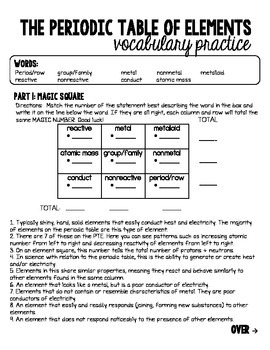
coordinating the naming of a new element, involving the research laboratory and allowing for public comments.assessing claims resulting in the validation and assignation of an element discovery.

defining the structure of a temporary name and symbol.establishing the criteria for a new element discovery.In particular, IUPAC is directly involved in the following: IUPAC involvement covers various aspects of the table and data that it unveils, and several reports and recommendations, some quite recent, attest of that input.
#Trends in the periodic table chemistry lab answers pdf#
– Access at a full resolution of this Table as PDF (made available by King’s Center for Visualization in Science).īy virtue of its work in relation with the chemical elements, IUPAC can dispense a periodic table that is up-to-date. – Review the latest IPTEI element-by-element review including a chart of all known stable and radioactive isotopes for each element and examples practical applications of isotopic measurements and technologies – Explore the interactive version at /isotopes-matter (or see release) – Read “Atomic Weights: No Longer Constants of Nature”, Chem Int 33(2), 10–15 (2011), IUPAC Periodic Table of the Elements and Isotopes (IPTEI) for the Educational Community Coplen, Peter Mahaffy, Ian Mills, Roberto Marquardt, and more. Leigh, Sigurd Hofmann, Eric Scerri, Juris Meija, Norman E. See PAC (AOP ) for full details or visit Commission II.1 ĭownload the PDF version (letter size or A4) or A3 (PDF) or see earlier versionsĬheck out SPECIAL Chem Int Jan 2019 - International Year of the Periodic Table (IYPT) - with contributions by Jan Reedijk, Natalia Tarasova, G.J. For elements that lack isotopes with a characteristic isotopic abundance in natural terrestrial samples, the mass number of the nuclide with the longest confirmed half-life is listed between square brackets. Needless to say, they were not correct in identifying the country and did not solve the mystery.The latest release of the Periodic Table (dated ) includes the most recent abridged standard atomic weight values released by the IUPAC Commission on Isotopic Abundances and Atomic Weights ( CIAAW), compiled as part of the 2021 Table of Standard Atomic Weights 2021. I did find, however, a few AP students tried to cut corners by trying to solve for the country before collecting all of their clues first. I have shared this activity with my colleague that teaches AP Chemistry as a quick review of material they should already know from their previous participation in a Chemistry class. I didn’t tell the students if they were correct or not, I simply handed them their boarding passes. They also thought the “airline tickets” I printed for the country for the correctly solved puzzles were an exciting touch. During one of my classes, one group of students was so excited to complete the puzzles before other groups that they cheered and jumped for joy as if they really had just saved the world.

My students forgot that they were reviewing for a chemistry test because they were having fun trying to solve the puzzles. Also incorporated within the puzzles are basic trends such as the number of subatomic particles, mass number, melting point, and other characteristics of specific elements. I use this mystery as a review to prepare for assessments over the properties of elements, symbols on the periodic table and the difference between groups and periods. This five puzzle mystery aligns with my chemistry curriculum after instruction on the properties of elements and electron configurations. Therefore, I had to determine the names of countries that could be spelled using the periodic table and whose names could be made out as a result of five puzzles. I decided to create five puzzles to fit within my class time of fifty minutes. I thought it would be fun to solve a mystery whose clues could be used to spell out the name of a country. I personally enjoy Escape the Classroom activities, but I could not find one that fit with my Chemistry class content.

Last year, I wanted to create a fun way to review Periodic Table concepts with my students instead of using the same review worksheet I had students complete in the past.


 0 kommentar(er)
0 kommentar(er)
